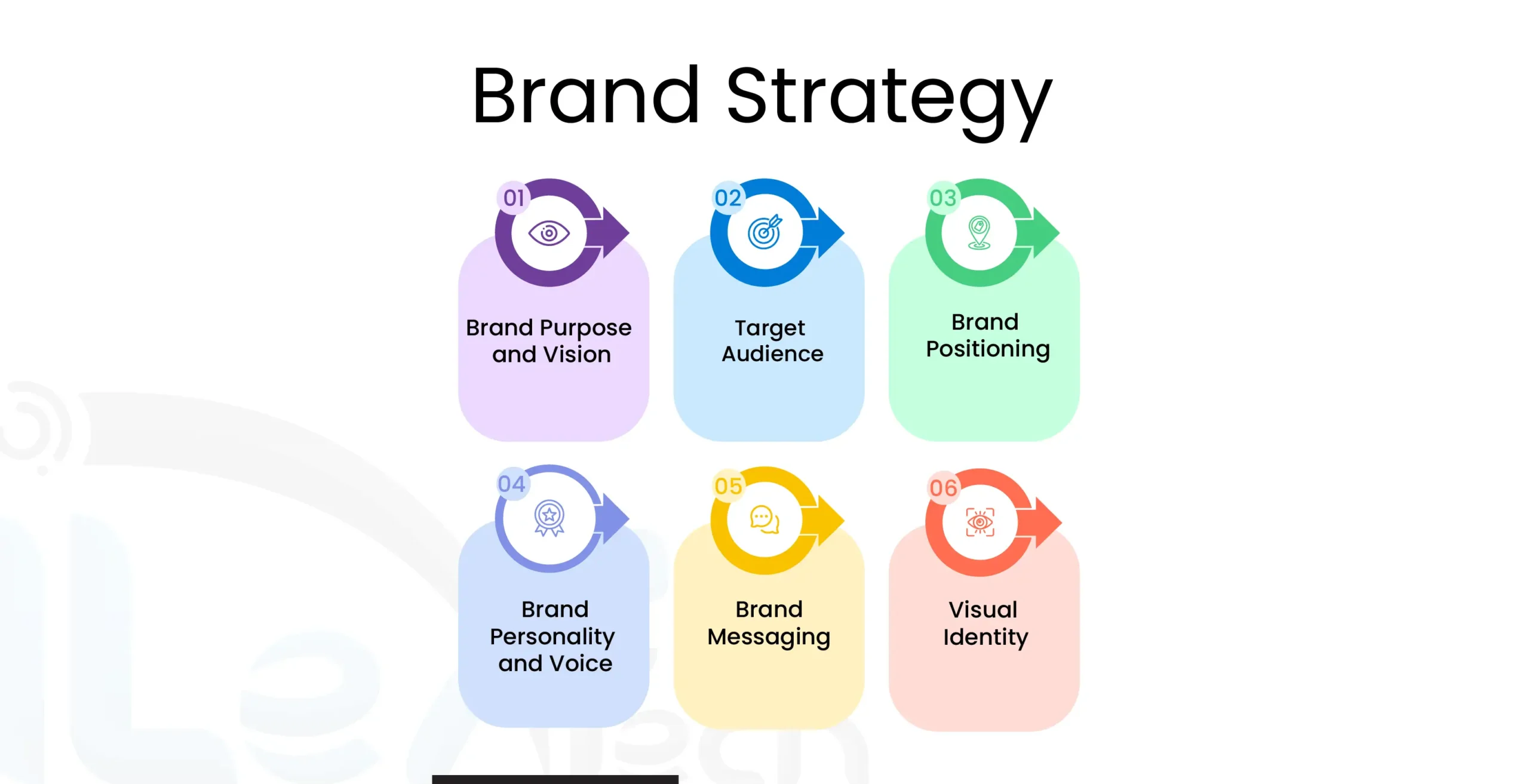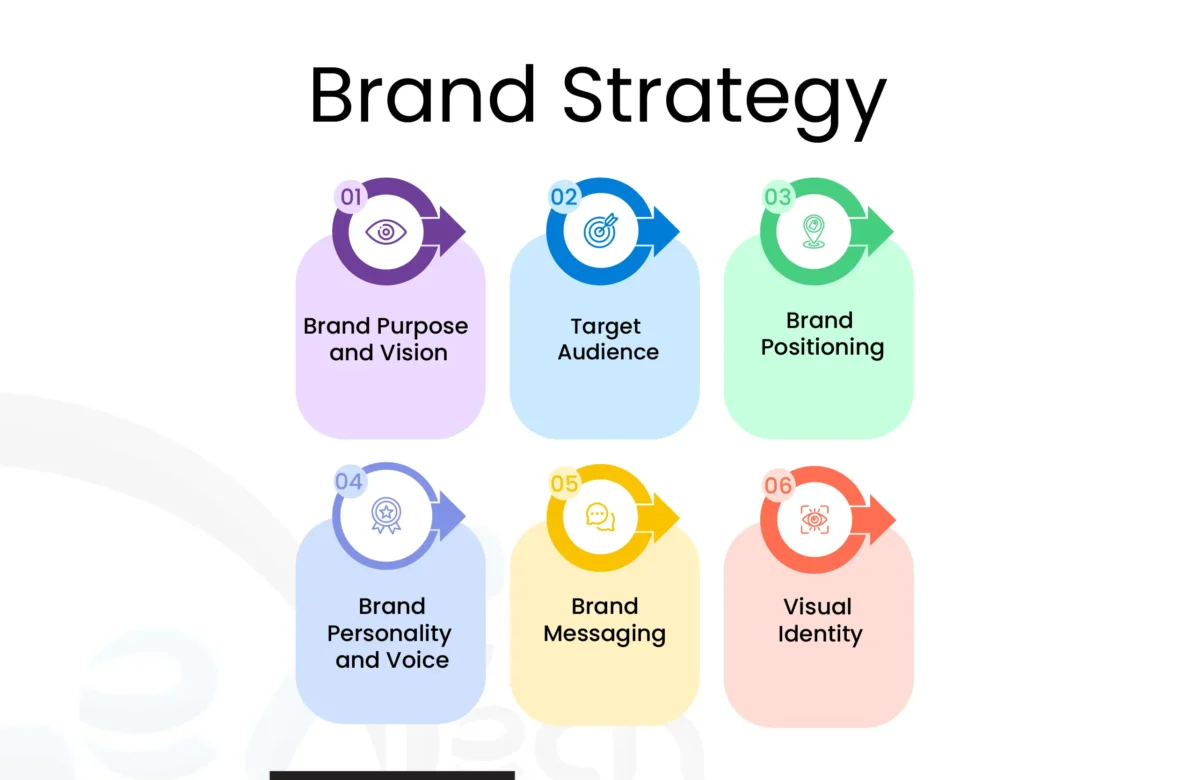In 2024, a brand is much more than just a name or a logo. It’s something that embodies the spirit of making a brand grow, encouraging loyalty, and allowing it to stand out from the crowd. A good brand strategy defines what a brand really stands for, how it communicates its self-image, and how it engages with its audience. Brand strategy and its components, as well as methods that companies may use in developing effective long-term strategies, are covered in this guide.
How to Define Brand Strategy Development for Business
A brand strategy is a long-term plan for how a brand will develop and establish itself in the market. It’s about identifying the unique value that your brand brings to the table and consistently communicating it to the right audience. Unlike one-time marketing campaigns, a brand strategy is a continuous effort that guides all business decisions and aligns them with the brand’s goals and values.
To define a brand strategy, businesses must clearly understand their mission, vision, and branding values. From there, they analyze their target audience, their competition, and the unique characteristics that set their brand apart.
In addition, the strategy should include the brand’s personality, voice, visual identity, and messaging framework. When these elements work together, they form a consistent brand experience that builds trust and loyalty among customers.
Developing a brand strategy is an ongoing process that involves:
- Defining the brand’s purpose – Why does the brand exist? What value does it offer?
- Identifying the target audience – Who does the brand serve, and what are their needs?
- Analyzing competitors – How does the brand differ from others in the market?
- Crafting a unique brand position – What makes the brand unique and valuable?
- Developing key messaging – What are the main messages and value propositions that will be communicated?
These foundational steps help create a brand strategy that not only resonates with customers but also provides a clear direction for all business activities, from marketing campaigns to product development.
Key Components of Brand Strategy
A strong brand strategy comprises several core components that work together to create a cohesive identity. So, here’s an overview of the most important ones:
1. Brand Purpose and Vision
The brand purpose explains why the brand is here, not to make money only. It looks at the bigger goal that the brand wants to reach or the effect that it wants to create. In fact, a good example would be that Nike’s purpose isn’t just to sell athletic clothing but to challenge people to be their best selves and find their inner athletes.
The brand vision depicts the future – what the brand and what it wants to be – thereby making decisions and shaping long-term goals. It goes ahead and motivates employees and consumers to work together with the brand and its mission.
2. Target Audience
Knowing the target audience is very important in making a good brand strategy. It means knowing the age, habits, and interests and understanding what they need, what problems they face, and what they like. The target audience will determine how the brand communicates, its style, and how it connects with the people it wants to reach.
3. Brand Positioning
Brand positioning is how customers perceive the brand and what makes it unique compared to others. Indeed, a well-positioned brand has a special place in the market, which becomes the first choice for target customers. For example, Volvo positions its brand by safety, which is unique from other car manufacturers.
4. Brand Personality and Voice
A brand’s personality and voice make it seem like a human, helping people connect with it. In addition, personality traits can be qualities like being trustworthy, playful, or sophisticated, while voice is the tone the brand always uses when communicating. For example, Apple’s brand personality is innovative and smooth, with a clear and inspiring voice.
5. Brand Messaging
Brand messaging is the set of key messages that convey the brand’s unique value propositions and benefits. This messaging aligns with the brand’s positioning and speaks directly to the target audience’s needs. Furthermore, consistent messaging across all channels reinforces the brand’s identity, building recognition and trust.
6. Visual Identity
The brand’s visual identity includes the logo, colors, typography, and design style. In addition, visual elements create an immediate impact and help customers recognize the brand. For instance, Coca-Cola’s red and white colors are instantly identifiable, reinforcing its classic and joyful personality.
7. Customer Experience
A strong brand strategy takes the customer experience into account, from the moment they first hear about the brand to post-purchase interactions. So, every touchpoint—whether online or in-store—should reflect the brand’s personality, values, and promise, creating a seamless and positive experience.
Types of Branding Strategies
Businesses can choose from various types of branding strategies, depending on their goals, industry, and audience. So, here are some of the most common types:
1. Personal Branding
Personal branding is creating a unique and memorable identity for an individual, often used by entrepreneurs, influencers, and public figures. This type of branding focuses on building trust, credibility, and a loyal following. In short, personal brands often use social media to establish an authentic and relatable presence.
2. Corporate Branding
Corporate branding focuses on creating a unified identity for an entire organization. This includes everything from company values to the visual identity that represents the organization. Examples include large corporations like Google and IBM, where the brand identity extends across all products and divisions.
3. Product Branding
Product branding is focused on a specific product and often involves a unique name, logo, and branding design that differentiates it from other products in the market. For example, the iPhone is a product brand within Apple’s corporate brand, and it has its own identity and loyal following.
4. Service Branding
Service branding emphasizes the experience and customer service that a brand offers. Companies in the hospitality and healthcare sectors often focus on service branding to build trust and loyalty among customers. For instance, Ritz-Carlton is known for its luxury service, central to its brand identity.
5. Co-Branding
Co-branding is a strategy where two brands collaborate on a product or campaign to leverage each other’s strengths. Examples include partnerships like Nike and Apple’s collaboration on fitness technology. Co-branding allows companies to reach new audiences and enhance their credibility.
6. Digital Branding
Digital branding is focused on building an online presence through websites, social media, and digital advertising. This type of branding is essential in today’s digital age, as consumers increasingly rely on online platforms to interact with brands. Digital branding involves consistent messaging and a strong visual identity across digital channels.
Example of Brand Strategy Development
Tesla is the best illustration of a company with a crystal clear brand strategy. Tesla’s brand strategy focuses primarily on new ideas, environmentalism, and luxury. Its aim is not only to sell vehicles but also to accelerate the world’s transition to sustainable energy. Tesla’s image of a modern, ‘green’ brand attracts loyal customers who are willing to spend money on its quality products.
As is fitting for Chief Executive Elon Musk, the brand of Tesla is aggressive and innovative. Its visual identity is front-loaded and avant-garde, displaying innovation through minimalism. Marketing proclaims technology, environmental good, and performance for the aspirational automotive brand.
Role of Brand Strategy in Marketing
Brand strategy plays a vital role in shaping marketing efforts by providing a clear direction and consistent messaging. Here’s how it impacts various aspects of marketing:
1. Guiding Marketing Campaigns
A well-defined brand strategy ensures all marketing campaigns align with the brand’s core message and values. It provides a framework for creating campaigns that resonate with the target audience and reinforce the brand identity.
2. Building Brand Awareness
A strong brand strategy helps create a recognizable and memorable brand, making it easier for customers to identify and remember. Consistent branding across channels contributes to greater brand awareness and recall.
3. Enhancing Customer Loyalty
When customers connect with a brand on an emotional level, they’re more likely to become loyal advocates. A strong brand strategy fosters this connection by reflecting values, personality, and a sense of community.
4. Differentiating from Competitors
In competitive markets, a unique brand strategy helps a company stand out by highlighting what makes it different. By defining a clear position and personality, brands can attract customers looking for specific attributes that competitors may not offer.
5. Supporting Long-Term Growth
A cohesive brand strategy provides a foundation for long-term growth by establishing a clear identity, building customer trust, and enabling consistency across all marketing activities.
Let Us Build Your Brand Strategy
Indeed, our strength is having a proper brand strategy. Therefore, Ilextech helps you stand out from the competition. We ensure you receive the full bouquet of brand strategy creation services, from saying who you are, matching your objectives, and feeling connected to your audience. Here is how we can help to grow your brand:
1. In-Depth Brand Analysis
We start by analyzing your brand’s current positioning, target audience, and competition to find areas to differentiate. In-depth research enables us to understand what sets your brand apart and how it can be made different.
2. Defining Brand Purpose and Positioning
We can help you define a clear purpose and position for your brand, aligning with your mission and values, and our team means making sure your brand communicates your unique value to the right audience-to build the base of growth and loyalty.
3. Developing Key Messaging and Visual Identity
Our experts create messages that show what’s great about your brand, connect to your audience, and make you different. We also design a unified visual identity that includes a logo, color scheme, and a set of fonts and reveals the character of the brand and attracts audiences.
4. Brand Storytelling and Content Strategy
You all know that storytelling is a powerful tool in building emotional connections. Thus, we create a brand story and content strategy that showcase your journey, values, and mission, helping you connect with your audience on a deeper level.
5. Ongoing Support and Adaptation
Brand strategy is an evolving process, and we offer ongoing support to refine and adapt your strategy as needed. We monitor performance, gather customer feedback, and adjust to ensure your brand remains relevant and impactful.
With Ilextech, you will be equipped with a talented team that actually cares for helping you design a brand that will communicate and inspire. Whether you are simply creating new brands or transforming old ones, we’re here to make it work for you at each step.
To conclude, we can say that a strong brand strategy is essential to creating a memorable brand. Also, a quarterly or yearly brand audit is necessary for successful brands. Branding is the real driver, and a good brand strategy guides marketing, increases customer loyalty, and provides businesses with a competitive edge through differentiation from competitors, thus influencing customer perception and interaction. Build a brand that reflects the values of yourself, connects with your audience, and becomes memorable.
FAQs
What are the four types of branding strategies?
The four types of branding strategies are Product Branding, Corporate Branding, Personal Branding, and Service Branding. Each strategy tailors branding efforts to meet specific business or personal goals.
What are the 4 C’s of brand strategy?
The 4 C’s of brand strategy are Clarity, Consistency, Credibility, and Connectivity. These principles ensure a brand’s message is clear, reliable, and resonates with its audience.
What is the brand strategy theory?
Brand strategy theory is a framework for positioning a brand to create lasting connections with its audience. It combines brand identity, target market insights, and consistent messaging for long-term brand equity.



